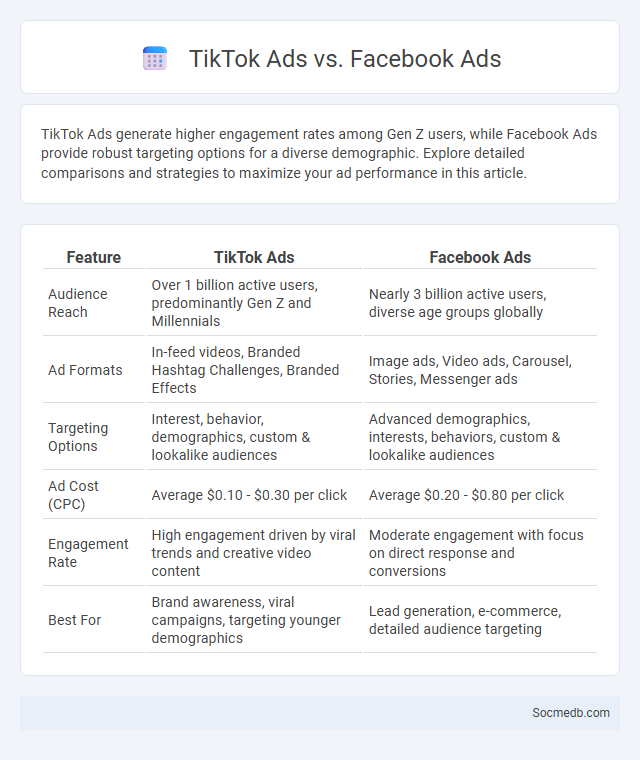
Photo illustration: TikTok Ads vs Facebook Ads
TikTok Ads generate higher engagement rates among Gen Z users, while Facebook Ads provide robust targeting options for a diverse demographic. Explore detailed comparisons and strategies to maximize your ad performance in this article.
Table of Comparison
| Feature | TikTok Ads | Facebook Ads |
|---|---|---|
| Audience Reach | Over 1 billion active users, predominantly Gen Z and Millennials | Nearly 3 billion active users, diverse age groups globally |
| Ad Formats | In-feed videos, Branded Hashtag Challenges, Branded Effects | Image ads, Video ads, Carousel, Stories, Messenger ads |
| Targeting Options | Interest, behavior, demographics, custom & lookalike audiences | Advanced demographics, interests, behaviors, custom & lookalike audiences |
| Ad Cost (CPC) | Average $0.10 - $0.30 per click | Average $0.20 - $0.80 per click |
| Engagement Rate | High engagement driven by viral trends and creative video content | Moderate engagement with focus on direct response and conversions |
| Best For | Brand awareness, viral campaigns, targeting younger demographics | Lead generation, e-commerce, detailed audience targeting |
Overview: TikTok Ads, Facebook Ads, and Community Building
TikTok Ads leverage short-form video content to engage younger audiences through creative and highly shareable campaigns, offering advanced targeting options based on user behavior and interests. Facebook Ads provide robust tools for precise audience segmentation and diverse ad formats, making it ideal for businesses seeking to reach broad demographics and drive conversions effectively. Building a strong community on these platforms enhances brand loyalty and encourages user-generated content, crucial for amplifying your social media presence and fostering meaningful interactions.
Audience Targeting Capabilities
Advanced audience targeting capabilities on social media platforms allow advertisers to reach specific demographics, interests, and behaviors with precision. By leveraging data from user activity, location, age, and purchasing habits, marketers can create highly personalized campaigns that maximize engagement and conversion rates. Your social media strategy benefits greatly from these tools by delivering relevant content to the right audience at the optimal time.
Content Formats and Creative Approaches
Exploring diverse content formats on social media such as videos, stories, reels, and carousels enhances engagement by catering to varied audience preferences. Creative approaches like interactive polls, user-generated content, and visually striking graphics help your brand stand out and foster authentic connections. Leveraging these strategies maximizes reach, boosts visibility, and drives meaningful interactions across platforms.
Ad Performance and ROI Comparison
Ad performance on social media platforms directly impacts ROI, with Facebook Ads delivering a 4.5% higher click-through rate (CTR) compared to Instagram. Data from Hootsuite indicates that LinkedIn ads generate the highest conversion rates for B2B campaigns, averaging 2.74%. Optimizing ad targeting and creative content enhances cost efficiency, with businesses reporting up to a 30% increase in ROI when leveraging platform-specific analytics tools.
Organic Reach vs Paid Reach
Organic reach on social media refers to the number of unique users who see content without paid promotion, primarily driven by algorithms, user engagement, and content relevance. Paid reach involves promoting content through advertising, targeting specific demographics to increase visibility beyond organic limits. Brands often balance organic reach for authentic engagement with paid reach strategies to amplify message delivery and achieve marketing goals.
Budget and Cost Efficiency
Maximizing your social media budget requires strategic allocation toward platforms with the highest engagement rates and conversion potential. Cost efficiency improves by leveraging targeted ads, which reduce wasted impressions and increase ROI through precise audience segmentation. Regular performance analysis helps you adjust spending to optimize results while minimizing unnecessary expenses.
Engagement Rates Across Platforms
Engagement rates on social media platforms vary significantly, with Instagram and TikTok typically showing higher interaction levels compared to Facebook and Twitter. TikTok's short-form video content drives up to 18% engagement rates, while Instagram averages around 1-3%, depending on niche and follower count. Monitoring your engagement metrics closely helps optimize content strategy and maximize audience connection.
Long-Term Brand Building Potential
Social media platforms offer unparalleled opportunities for long-term brand building through consistent engagement and content sharing that fosters community loyalty. Utilizing analytics and targeted advertising enhances brand visibility while enabling tailored messaging that resonates with specific audience segments. Strategic storytelling and authentic interactions on these channels contribute to sustained brand recognition and trust over time.
Analytics and Tracking Tools
Social media analytics and tracking tools enable businesses to measure user engagement, reach, and conversion rates across platforms like Facebook, Instagram, and Twitter. These tools utilize data metrics such as click-through rates, impressions, sentiment analysis, and demographic insights to optimize marketing strategies. Platforms like Google Analytics, Hootsuite, and Sprout Social provide comprehensive dashboards for real-time monitoring and in-depth reports to enhance campaign performance.
Choosing the Right Strategy for Your Business
Choosing the right social media strategy for your business involves analyzing your target audience demographics and platform-specific engagement metrics to maximize reach and conversion. Leveraging data-driven insights such as content performance, posting frequency, and competitor analysis ensures optimized campaign effectiveness and ROI. Tailoring your approach based on these factors empowers you to build brand awareness and foster customer loyalty in a competitive digital landscape.
 socmedb.com
socmedb.com